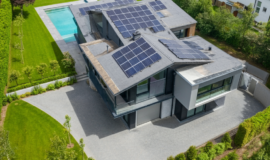Nuclear Power Phase-out
As we already know, a nuclear power plant, or NPP for short, is a thermal power plant which uses a nuclear reactor as a heat source. It operates in the same way as the thermo power station – the heat is used to generate steam which then drives the steam turbine. The steam turbine is connected to a generator which then produces electricity.
Nuclear power plants are responsible for around 10% of the world’s electricity production, which is produced by 455 nuclear power plants. In 2020, the electricity production was estimated at 2553 TWh, down from 2657 TWh in 2019. In the last period, countries from all over the world are aspiring to decrease the usage of nuclear power plants, aka are aspiring to achieve nuclear power phase-out. Nuclear power phase-out is a part of the energy transition towards a carbon-free future. It is also initiated because of the concerns about using nuclear power, especially after the 1979 Three Mile Island partial nuclear meltdown in the USA, the 1986 Chernobyl disaster in Ukraine and the 2011 Fukushima nuclear disaster in Japan.
In 2019, 13 EU countries had working nuclear generators: Belgium, Bulgaria, Czechia, Germany, Spain, France, Hungary, the Netherlands, Romania, Slovenia, Slovakia, Finland and Sweden with an electricity production of 26,4% from the total production. The electricity production in Europe from nuclear power has been lowered by 16,3 % between 2006 and 2019.
Italy is the first country that has permanently shut down all of its reactors (as of 2020). Germany, Switzerland, Spain and Belgium plan to phase-out nuclear power by 2030. Germany has a total of 17 nuclear reactors and 8 of them are already shut down. Spain and Switzerland have banned the construction of new power plants. The United Kingdom generates around 20% of electricity form nuclear power plants but is planning on retiring half of that capacity by 2050. Japan shut down its 50 nuclear power reactors in the wake of Fukushima, but later in 2014 decided to start operating reactors again after a security check. France on the other hand, derives about 75% of its electricity from nuclear energy. The country has highly developed nuclear technology. The French government has passed an energy bill in 2015 that said that it would reduce its energy generation from nuclear power from 75 to 50 percent until 2025, but said in November 2017 that this target was not realistic and would put the security of supply in danger. But still, their government policy is to reduce production from nuclear power plants until 2035.
31 countries have operation nuclear power plants. According to the The World Nuclear Industry Status Report 2017, the historic peak of nuclear power plant electricity production was in 1996 (17,6%) and since then has been steadily declined. Although some countries plan on building new nuclear reactors, most of them are shutting them down. Nowadays, global investments in new power plants go to renewables such as solar and wind, followed by fossil fuels and some smaller percent is spent on nuclear power plants and I think it’s going to continue that way for a safer and greener future.





